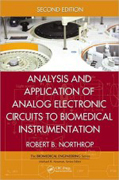
Analysis and application of analog electronic circuits to biomedical instrumentation
Northrop, Robert B.
Analysis and Application of Analog Electronic Circuits to Biomedical Instrumentation, Second Edition helps biomedical engineers understand the basic analogelectronic circuits used for signal conditioning in biomedical instruments. It explains the function and design of signal conditioning systems using analogICs--the circuits that enable ECG, EEG, EMG, ERG, tomographic images, biochemical spectrograms, and other crucial medical applications. This book demonstrates how op amps are the keystone of modern analog signal conditioning system design and illustrates how they can be used to build instrumentation amplifiers, active filters, and many other biomedical instrumentation systems and subsystems. It introduces the mathematical tools used to describe noise and its propagation through linear systems, and it looks at how signal-to-noise ratios canbe improved by signal averaging and linear filtering. Features Analyzes the properties of photonic sensors and emitters and the circuits that power them Details the design of instrumentation amplifiers and medical isolation amplifiers Considers the modulation and demodulation of biomedical signals Examines analog power amplifiers, including power op amps and class D (switched) PAs Describes wireless patient monitoring, including Wi-Fi and Bluetooth communication protocols Explores RFID, GPS, and ultrasonic tags and the design of fractal antennas Addresses special analog electronic circuits and systems such as phase-sensitive rectifiers, phase detectors, and IC thermometers By explaining the "building blocks" of biomedical systems, the author illustrates the importance of signal conditioning systems in the devices that gather and monitor patients' critical medical information. Fully revised and updated, this second editionincludes new chapters, a glossary, and end-of-chapter problems. What's New inThis Edition Updated and revised material throughout the book A chapter on the applications, circuits, and characteristics of power amplifiers A chapter onwireless patient monitoring using UHF telemetry A chapter on RFID tags, GPS tags, and ultrasonic tags A glossary to help you decode the acronyms and terms used in biomedical electronics, physiology, and biochemistry New end-of-chapter problems and examples INDICE: All chapters include an introduction and chapter summary. Sources and Properties of Biomedical Signals Sources of Endogenous Bioelectric SignalsNerve Action Potentials Muscle Action Potentials The Electrocardiogram Other Biopotentials Electrical Properties of Bioelectrodes Exogenous Bioelectric Signals Properties and Models of Semiconductor Devices Used in Analog Electronic Systems pn Junction Diodes Midfrequency Models for BJT Behavior Midfrequency Models for Field-Effect Transistors High-Frequency Models for Transistors and Simple Transistor Amplifiers Photons, Photodiodes, Photoconductors, LEDs, and Laser Diodes The Differential Amplifier DA Circuit Architecture Common-Mode Rejection Ratio CM and DM Gain of Simple DA Stages at High Frequencies Input Resistance of Simple Transistor DAs How Signal Source Impedance Affects the Low-Frequency CMRR How Op Amps Can be Used to Make DAs for Medical Applications General Properties of Electronic, Single-Loop Feedback Systems Classification of Electronic Feedback Systems Some Effects of Negative Voltage Feedback Effects of Negative Current Feedback Positive Voltage Feedback Feedback, Frequency Response, and Amplifier Stability Review of Amplifier Frequency Response What Is Meant by Feedback System Stability The Use of Root Locus in Feedback Amplifier Design Use of Root-Locus in the Design of "Linear" Oscillators Operational Amplifiers and Comparators The Ideal Op Amp Practical Op Amps Gain-Bandwidth Relations for Voltage-Feedback OAs Gain-Bandwidth Relations in Current Feedback Amplifiers Analog Voltage Comparators Some Applications of Op Amps in Biomedicine Introduction to Analog Active Filters Active Filter Applications Types of Analog Active Filters Electronically Tunable AFs Instrumentation and Medical Isolation Amplifiers Instrumentation Amps Medical Isolation Amps Safety Standardsin Medical Electronic Amplifiers Medical-Grade Power Supplies Noise and the Design of Low-Noise Signal Conditioning Systems for Biomedical Applications Descriptors of Random Noise in Biomedical Measurement Systems Propagation of Noise Through LTI Filters Noise Factor and Figure of Amplifiers Cascaded Noisy Amplifiers Noise in Differential Amplifiers Effect of Feedback on Noise Examples of Noise-Limited Resolution of Certain Signal Conditioning Systems Some Low-Noise Amplifiers The Art of Low-Noise Signal Conditioning System Design Digital Interfaces Aliasing and the Sampling Theorem Digital-to-Analog Converters Sample-and-Hold Circuits Analog-to-Digital Converters Quantization Noise Modulation and Demodulation of Biomedical Signals Modulation of a Sinusoidal Carrier Viewed in the Frequency Domain Implementation of AM Generation of Phase and Frequency Modulation Demodulation of Modulated Sinusoidal Carriers Modulation and Demodulation of Digital Carriers Power Amplifiers and Their Applications in Biomedicine Power Output Devices Classes of Power Amplifiers: PA Efficiency Class D Power Amplifiers Nonlinearity and Distortion in PAs IC Voltage Regulators in Medical Electronic Systems Heatsinking Wireless Patient Monitoring Sensors and Sensor Signals Communicated in WPM Modulation in WPM RF Communications Protocols Used in WPM UHF Transmitters and Antennas WPM Systems How WPM Reduces the Probability of Patient Microshock Privacy in WPM RFID Tags, GPS Tags, and Ultrasonic Tags Used in Ecological Research Applications of RFID Tags Design ofRFID Tags Tag Readers GPS Tags Ultrasonic Tags in Fisheries Biology Examples of Special Analog Circuits and Systems Used in Biomedical Instrumentation The Phase-Sensitive Rectifier Phase Detectors Voltage and Current-Controlled Oscillators Phase-Lock Loops True RMS Converters IC Temperature Sensors Three Examples of Medical Instrumentation Systems Appendix Glossary Bibliography and Recommended Reading
- ISBN: 978-1-4398-6669-6
- Editorial: CRC Press
- Encuadernacion: Cartoné
- Páginas: 538
- Fecha Publicación: 01/04/2012
- Nº Volúmenes: 1
- Idioma: Inglés
